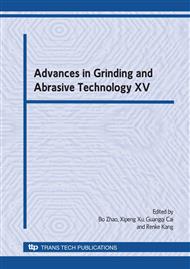p.558
p.563
p.568
p.572
p.578
p.583
p.588
p.593
p.598
Experimental Study on the Dressing Force of Super-Abrasive Grinding Wheel with Elliptic Ultrasonic Vibration
Abstract:
A new dressing device for dense type diamond grinding wheel, whose elliptic vibration was prompted by single longitudinal vibration, was designed using a local resonance method. It was employed to dress the metallic bond super-abrasive grinding wheel and the dressing force characteristics were analyzed. The results indicate that the thrust force decreased to 1/7-1/10 of that of conventional method, and the main cutting force decreased by 70%. Compared to other dressing parameters, the dressing force in elliptic ultrasonic vibration was more sensitive to grinding speed. Thrust force and main cutting force increased rapidly when rotation speed beyond 72rpm. But when the ultrasonic power was higher than 50W, dressing force decreased very slowly. It was observed that the new dressing method is contribute to better surface finish such as more even surface, less crush abrasives, more uniform abrasive abscission and so on than the conventional method.
Info:
Periodical:
Pages:
578-582
Citation:
Online since:
September 2009
Authors:
Price:
Сopyright:
© 2009 Trans Tech Publications Ltd. All Rights Reserved
Share:
Citation:


